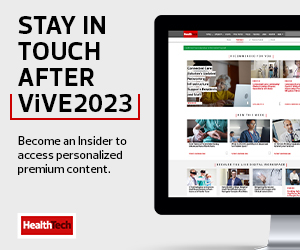What’s So Difficult About Digital Transformation in Healthcare?
In the session “Building the Digital Transformation Plane while Flying,” Dr. Sean Kelly, chief medical officer and senior vice president of healthcare strategy for Imprivata, compared the healthcare and financial services industries. In the past, people had to go to a physical bank to complete transactions. Then ATMs made it easier to withdraw cash. Now, most banking is done online or through an app.
“There’s no banking and telebanking; it’s just banking. So why do we talk about healthcare and telehealth?” Kelly asked.
William Walders, CIO and senior vice president of integrated delivery network operations at Health First, said decades-old, legacy systems are what make digital transformation so difficult in healthcare. Many organizations also have several electronic medical records, which can make it difficult to offer a seamless experience for clinicians and patients.
Another barrier to digital transformation is culture. Mt. San Rafael Hospital CIO Michael Archuleta explained that many in the industry have always seen technology as a cost center rather than a strategic revenue contributor.
LEARN MORE: How strong leadership and integrated tools support hybrid care.
“We’re one of the most antiquated industries out there. We’re doing the most important thing by saving people’s lives and enhancing patient care, but we’re behind the curve,” he said. “Healthcare should be leading the pack in innovation and digital transformation. We don’t need a business makeover, but a true technology revolution.”
Archuleta advocated for more focus on improving organizations’ culture. He recommended that organizations bring in startups to accelerate innovation.
Data insights have the potential to transform healthcare, but much of it isn’t easily accessible for analysis. Chris Carmody, CTO for the University of Pittsburgh Medical Center, said his organization has 6 trillion data points for approximately 110 of its 3,600 applications.
“We’re just scratching the surface of learning from the data we already have. Most of that data is unstructured,” Carmody said. “Generative AI can be used in different forms to extract meaning, which will help with digital transformation.”
Moving Digital Transformation Forward in Healthcare
Increased collaboration makes it more likely for healthcare organizations to achieve digital transformation. Tressa Springmann, senior vice president and chief information and digital officer at LifeBridge Health, said she is most proud of her relationship with her organization’s chief marketing officer and the marketing team. This relationship has enabled her and her team to gain a better understanding of the community and how best to reach potential patients via digital-first initiatives.
Carmody explained that he is focused on building and establishing relationships that haven’t existed in the past, such as with the chief analytics officer and data scientists to define direction and vision in UPMC’s data analytics program. Rather than being reactive, as the organization often had to be during the height of the pandemic, UPMC is now being proactive.
“Instead of building technology for use within the four walls of the hospital, we’re making our clinical services accessible to the communities we serve,” he said. “I’m optimistic. We have a great opportunity in the next few years to transform healthcare. Others, like Amazon, want to take what they do well and apply it to healthcare, but they don’t know healthcare like we do. We have to be innovative to transform healthcare.”
DIVE DEEPER: Learn about the best practices for digital transformation in senior care.
If a healthcare organization wants to be successful, Archuleta said, it needs to redefine the culture. He described patients as “the new CEO in healthcare,” meaning organizations need to cater to patient demands for digital-first experiences using tools such as asynchronous technology.
Partnerships are also important as health IT leaders and teams navigate technology implementations. Carmody warned against working with vendors that don't include assessments from an IT architecture perspective to determine how the new technology will fit into an organization’s existing ecosystem. They could be using a rogue website or cloud service, which would be a challenge to deal with after the fact.
“If someone says not to include IT, don’t listen to them,” added Springmann.
Archuleta agreed that IT has to be a core component of technology implementations. He pointed out that he’s seen failures when IT wasn’t involved, especially when it comes to security.














